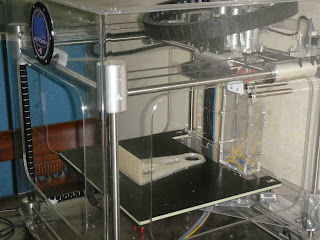...according to Fabbaloo:
Price: While prices of current personal 3D printers are massively lower than their commercial counterparts, the price of the easy-to-use, more reliable pre-assembled models still ranges well over USD$1000 and in some cases over USD$2000. The price levels must be far less than USD$500 if they are to be affordable by most homes.
Ease of Use: The required workflow to use a personal 3D printer these days is just too complex for most people. Using multiple software environments involving a variety of mysterious file formats, strange devices, unusual materials is enough to make most people give up and move on to something easier. Machines must take more care of themselves, software must be integrated into existing workflows and be vastly simplified.
Reliability: While personal 3D printers are available, they don't always work. Every owner has plenty of tales describing prints "that failed", perhaps due to material issues, insufficient bed sticking or other common phenomena. We would not like a 2D printer that had similar failure characteristics, so why would we stand for the same in a 3D printer?
Choice of Materials: ABS or maybe PLA. That's typically what you get today - and while these materials are quite usable in a variety of situations, they don't work all the time. People will need the ability to create objects in other materials, including food, ceramics, metal and perhaps other substances for different applications. Not an easy barrier to overcome, but that's the truth.
Availability of Materials: Where did you find that 1.75mm Tartan filament again? That's right - you can't find 3D printing suppliers at the corner electronics shop, or sometimes even at your local industrial plastics supply outlet. When personal 3D printers become more ubiquitous we'll begin to see brand-named print material showing up at the big box stores. But that hasn't happened yet. We're still looking for that elusive Tartan filament, though.
Access to 3D Models: We all can imagine the difficulties the general public would have trying to learn one of the professional 3D modeling software tools, so that's just not gonna happen. There have been some tremendous steps forward here, namely Tinkercad and similar web-based tools, but they don't yet offer the modeling sophistication we think necessary for broad adoption. A simple, effective and cheap 3D scanning solution may help here. There are a few places one can obtain quality 3D models, but it's just not big enough to satisfy the needs of the general public yet. The good news is that every 3D printable model created going forward will add to the growing mountain.
Print Resolution: Smoother is better. Much smoother.
Color: We suspect people will get tired of monocolored objects very quickly and the next frontier will be color 3D printing. At the moment only ZCorp (recently purchased by 3D Systems) has great color output. We hope this technology will eventually emerge in all personal 3D printers.
Speed: 3D printing is achingly slow, particularly for high-resolution or larger objects. And don't even think of printing large objects at a high resolution! The speed issue must be solved otherwise the general public will be hugely disappointed.
Safety: What's that smell when you're printing that object? It's airborne ABS fumes diffusing into your home. Are they safe? Probably. Maybe. Um, we'd better check. There are a number of safety concerns regarding personal 3D printing that must be sorted out over the next few years. You can be certain that once 3DP reaches mass popularity the space will be intensely inspected by many interested parties. Safety first!
Some of these barriers are overcome by using a 3D print service, but not all. However, we suspect there will always be a psychological tend towards owning your own device, if it actually works for you. In other words, a lot of people will work to resolve all these barriers. Will they remove them all in the next few years? Probably some of them. The rest, later.
Via
Fabbaloo
















